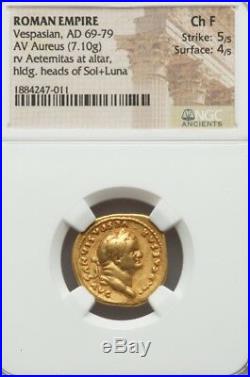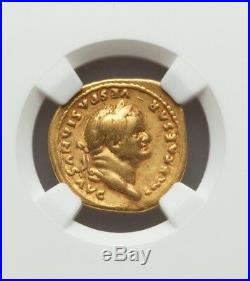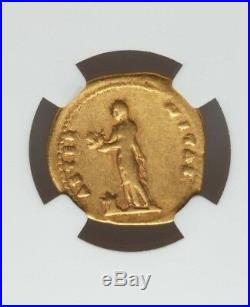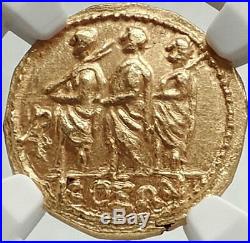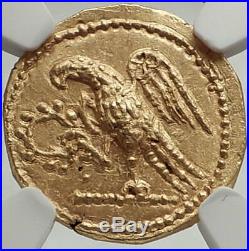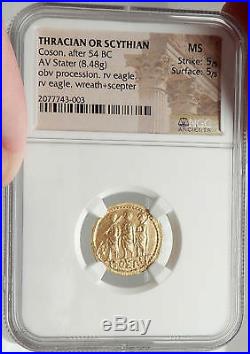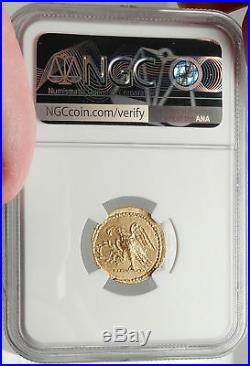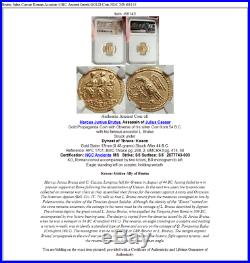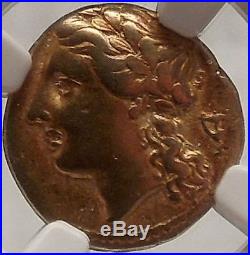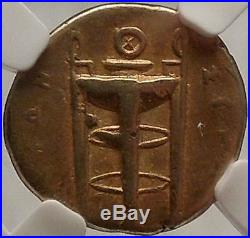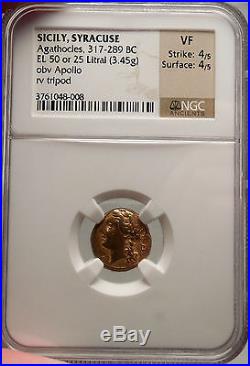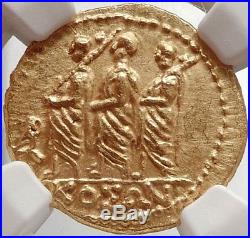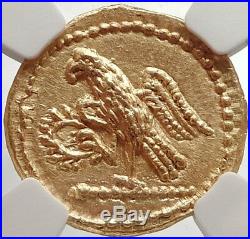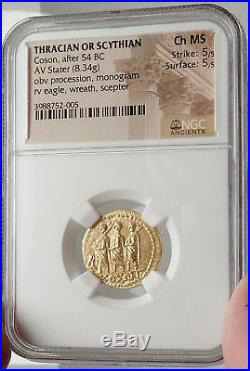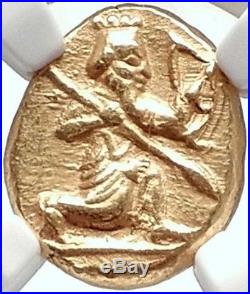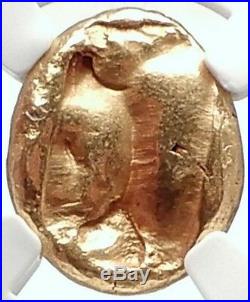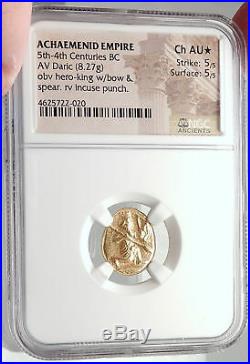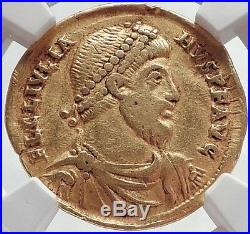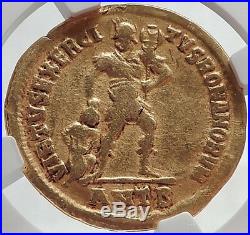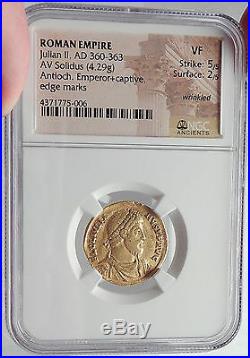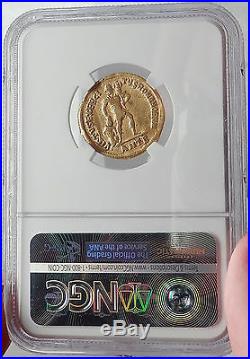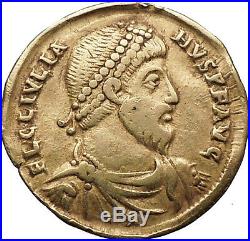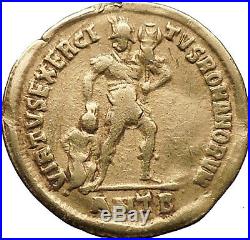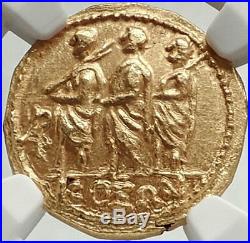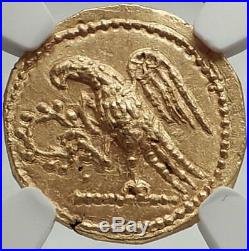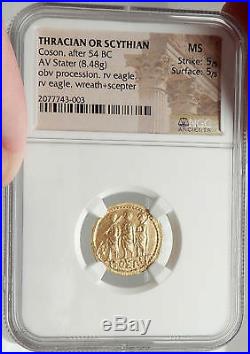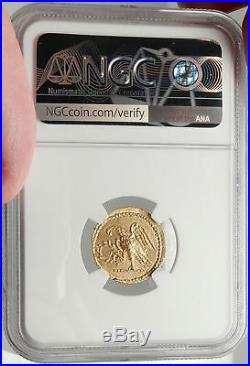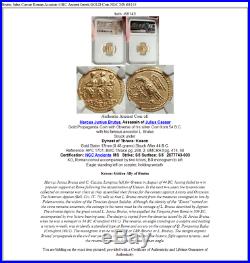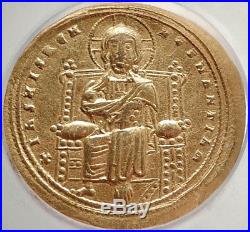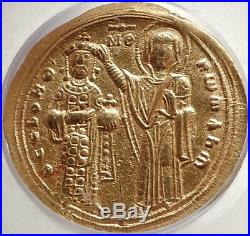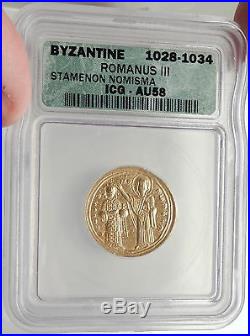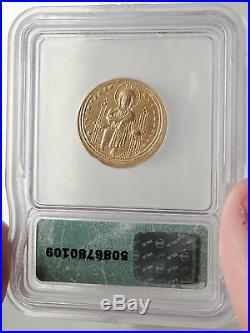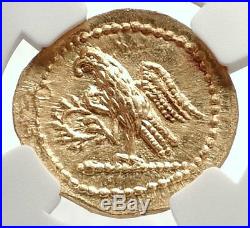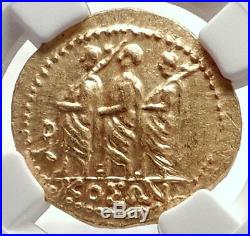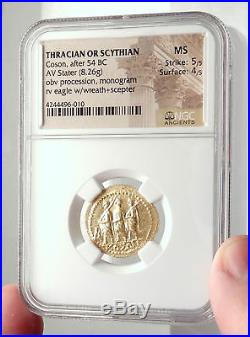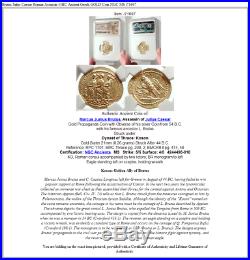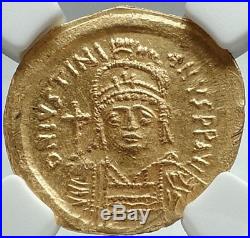
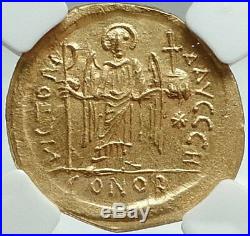
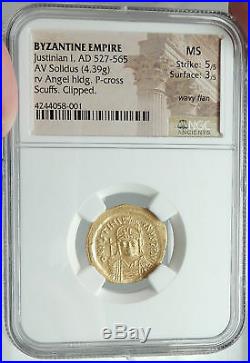
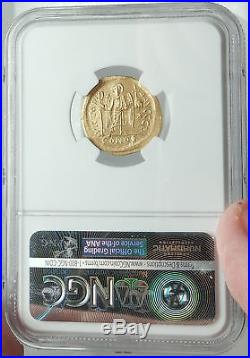


Item: i66183 Authentic Ancient Coin of. Justinian I’The Great. Emperor: 1 August 527 – 14 November 565 A. Gold Solidus 20mm (4.39 grams) Constantinople, 8th officina Reference: Sear 140 Certification: NGC Ancients. MS Strike: 5/5 Surface: 3/5 4244058-001 D N IVSTINIANVS P P AVI, helmeted, cuirassed bust of Justinian facing, globus cruciger in right hand, shield with horseman motif in left. VICTORIA AVGGG H, Angel (victory) standing facing, long linear staff surmounted by staurogram in right hand, globus cruciger in left; Star in right field, CONOB in exergue. The Staurogram meaning monogram of the cross, from the Greek , i. Cross , or Monogrammatic Cross or Tau-Rho symbol, is composed by a tau superimposed on a rho . The Staurogram was first used to abbreviate the Greek word for cross in very early New Testament manuscripts such as P66, P45 and P75, almost like a nomen sacrum, and may visually have represented Jesus on the cross. Ephrem the Syrian in the 4th-century explained these two united letters stating that the tau refers to the cross, and the rho refers to the Greek word “help” which has the numerological value in Greek of 100 as the letter rho has. In such a way the symbol expresses the idea that the Cross saves. The two letters tau and rho can also be found separately as symbols on early Christian ossuaries. The tau was considered a symbol of salvation due to the identification of the tau with the sign which in Ezekiel 9:4 was marked on the forehead of the saved ones, or due to the tau-shaped outstretched hands of Moses in Exodus 17:11. The rho by itself can refer to Christ as Messiah because Abraham, taken as symbol of the Messiah, generated Isaac according to a promise made by God when he was one hundred years old, and 100 is the value of rho. The Monogrammatic Cross was later seen also as a variation of the Chi Rho symbol, and it spread over Western Europe in the 5th and 6th centuries. In ancient Roman religion, Victoria or Victory was the personified goddess of victory. She is the Roman equivalent of the Greek goddess Nike, and was associated with Bellona. She was adapted from the Sabine agricultural goddess Vacuna and had a temple on the Palatine Hill. The goddess Vica Pota was also sometimes identified with Victoria. Unlike the Greek Nike , the goddess Victoria (Latin for “victory”) was a major part of Roman society. Multiple temples were erected in her honor. When her statue was removed in 382 CE by Emperor Gratianus there was much anger in Rome. She was normally worshiped by triumphant generals returning from war. Also unlike the Greek Nike, who was known for success in athletic games such as chariot races, Victoria was a symbol of victory over death and determined who would be successful during war. Victoria appears widely on Roman coins, jewelry, architecture, and other arts. She is often seen with or in a chariot, as in the late 18th-century sculpture representing Victory in a quadriga on the Brandenburg Gate in Berlin, Germany; “Il Vittoriano” in Rome has two. Winged figures, very often in pairs, representing victory and referred to as “victories”, were common in Roman official iconography, typically hovering high in a composition, and often filling spaces in spandrels or other gaps in architecture. These represent the spirit of victory rather than the goddess herself. They continued to appear after Christianization of the Empire, and slowly mutated into Christian angels. The symbolism of angels has been adopted from the ancient Roman goddess of victory by the early Christians. The goddess transformed into what is known by the Christians as angels via the Christianization of the Roman empire. This is evidenced by many coins still depicting victory, yet of the time period where Christianity was already the official religion of the Roman empire. She appears along with symbols such as a Christogram (also known as a Chi-Rho which is a monogram of Jesus Christ), Staurogram, and the cross, attributing to it’s Christian symbolism. An angel is a purely spiritual being found in various religions and mythologies. In Abrahamic religions and Zoroastrianism, angels are often depicted as benevolent celestial beings who act as intermediaries between God or Heaven and Earth, or as guardian spirits or a guiding influence. Other roles of angels include protecting and guiding human beings, and carrying out God’s tasks. The term “angel” has also been diversified to various notions of spirits or figures found in many other religious traditions. The theological study of angels is known as “angelology”. In art, angels are often depicted with bird-like wings on their back, a halo, robes and various forms of glowing light. Justinian I (Latin: Flavius Petrus Sabbatius Iustinianus Augustus , Greek: Flábios Pétros Sabbátios Ioustinianos) c. 482 – 14 November 565, traditionally known as Justinian the Great and also Saint Justinian in the Orthodox Church, was a Byzantine (East Roman) emperor from 527 to 565. During his reign, Justinian sought to revive the empire’s greatness and reconquer the lost western half of the historical Roman Empire. One of the most important figures of late antiquity and possibly the last Roman emperor to speak Latin as a first language, Justinian’s rule constitutes a distinct epoch in the history of the Later Roman empire. The impact of his administration extended far beyond the boundaries of his time and domain. Justinian’s reign is marked by the ambitious but only partly realized renovatio imperii , or “restoration of the Empire”. Because of his restoration activities, Justinian has sometimes been called the “last Roman” in modern historiography. This ambition was expressed by the partial recovery of the territories of the defunct western Roman empire. His general, Belisarius, swiftly conquered the Vandal kingdom in North Africa, re-extending Roman control to the Atlantic Ocean. Subsequently Belisarius, Narses, and other generals conquered the Ostrogothic kingdom, restoring Dalmatia, Sicily, Italy, and Rome to the empire after more than half a century of rule by the Ostrogoths. The prefect Liberius reclaimed most of southern Iberia, establishing the province of Spania. These campaigns re-established Roman control over the western Mediterranean, increasing the Empire’s annual revenue by over a million solidi. During his reign Justinian also subdued the Tzani , a people on the east coast of the Black Sea that had never been under Roman rule before. A still more resonant aspect of his legacy was the uniform rewriting of Roman law, the Corpus Juris Civilis , which is still the basis of civil law in many modern states. This work was carried out primarily by his quaestor Tribonian. His reign also marked a blossoming of Byzantine culture, and his building program yielded such masterpieces as the church of Hagia Sophia, which was to be the center of Eastern Orthodox Christianity for many centuries. A devastating outbreak of bubonic plague (see Plague of Justinian) in the early 540s marked the end of an age of splendour. The Empire entered a period of territorial decline not to be reversed until the 9th century. Procopius provides the primary source for the history of Justinian’s reign. The Syriac chronicle of John of Ephesus, which does not survive, was used as a source for later chronicles, contributing many additional details of value. Both historians became very bitter towards Justinian and his empress, Theodora. Other sources include the histories of Agathias, Menander Protector, John Malalas, the Paschal Chronicle, the chronicles of Marcellinus Comes and Victor of Tunnuna. Justinian is considered a saint among Eastern Orthodox Christians, and is also remembered by some in the Lutheran Church on November 14. Justinian was born in Tauresium around 482. His Latin-speaking peasant family is believed to have been of Thraco-Roman or Illyro-Roman origins. The cognomen Iustinianus , which he took later, is indicative of adoption by his uncle Justin. During his reign, he founded Justiniana Prima not far from his birthplace, today in South East Serbia. His mother was Vigilantia, the sister of Justin. Justin, who was in the imperial guard (the Excubitors) before he became emperor, adopted Justinian, brought him to Constantinople, and ensured the boy’s education. As a result, Justinian was well educated in jurisprudence, theology and Roman history. Justinian served for some time with the Excubitors but the details of his early career are unknown. Chronicler John Malalas, who lived during the reign of Justinian, tells of his appearance that he was short, fair skinned, curly haired, round faced and handsome. Another contemporary chronicler, Procopius, compares Justinian’s appearance to that of tyrannical Emperor Domitian, although this is probably slander. When Emperor Anastasius died in 518, Justin was proclaimed the new emperor, with significant help from Justinian. During Justin’s reign (518-527), Justinian was the emperor’s close confidant. Justinian showed much ambition, and it has been thought that he was functioning as virtual regent long before Justin made him associate Emperor on 1 April 527, although there is no conclusive evidence for this. As Justin became senile near the end of his reign, Justinian became the de facto ruler. Justinian was appointed consul in 521 and later commander of the army of the east. Upon Justin’s death on 1 August 527, Justinian became the sole sovereign. As a ruler, Justinian showed great energy. He was known as “the emperor who never sleeps” on account of his work habits. Nevertheless, he seems to have been amiable and easy to approach. Around 525, he married his mistress, Theodora, in Constantinople. She was by profession a courtesan and some twenty years his junior. In earlier times, Justinian could not have married her because of her class, but his uncle, Emperor Justin I, had passed a law allowing intermarriage between social classes. Theodora would become very influential in the politics of the Empire, and later emperors would follow Justinian’s precedent in marrying outside the aristocratic class. The marriage caused a scandal, but Theodora would prove to be shrewd judge of character and Justinian’s greatest supporter. Justinian’s rule was not universally popular; early in his reign he nearly lost his throne during the Nika riots, and a conspiracy against the emperor’s life by dissatisfied businessmen was discovered as late as 562. Justinian was struck by the plague in the early 540s but recovered. Theodora died in 548 at a relatively young age, possibly of cancer; Justinian outlived her by nearly twenty years. Justinian, who had always had a keen interest in theological matters and actively participated in debates on Christian doctrine, became even more devoted to religion during the later years of his life. When he died on 14 November 565, he left no children, though his wife Theodora had given birth to a stillborn son several years into his reign. He was succeeded by Justin II, who was the son of his sister Vigilantia and married to Sophia, the niece of Empress Theodora. Justinian’s body was entombed in a specially built mausoleum in the Church of the Holy Apostles until it was desecrated and robbed during the pillage of the city in 1204 by the Latin States of the Fourth Crusade. Main article: Corpus Juris Civilis. Justinian achieved lasting fame through his judicial reforms, particularly through the complete revision of all Roman law, something that had not previously been attempted. The total of Justinian’s legislature is known today as the Corpus juris civilis. It consists of the Codex Iustinianus , the Digesta or Pandectae , the Institutiones , and the Novellae. Early in his reign, Justinian appointed the quaestor Tribonian to oversee this task. The first draft of the Codex Iustinianus , a codification of imperial constitutions from the 2nd century onward, was issued on 7 April 529. The final version appeared in 534. It was followed by the Digesta (or Pandectae), a compilation of older legal texts, in 533, and by the Institutiones , a textbook explaining the principles of law. The Novellae , a collection of new laws issued during Justinian’s reign, supplements the Corpus. As opposed to the rest of the corpus, the Novellae appeared in Greek, the common language of the Eastern Empire. The Corpus forms the basis of Latin jurisprudence (including ecclesiastical Canon Law) and, for historians, provides a valuable insight into the concerns and activities of the later Roman Empire. As a collection it gathers together the many sources in which the leges (laws) and the other rules were expressed or published: proper laws, senatorial consults (senatusconsulta), imperial decrees, case law, and jurists’ opinions and interpretations (responsa prudentum). Tribonian’s code ensured the survival of Roman law. It formed the basis of later Byzantine law, as expressed in the Basilika of Basil I and Leo VI the Wise. The only western province where the Justinianic code was introduced was Italy (after the conquest, by the so-called Pragmatic Sanction of 554), from where it was to pass to Western Europe in the 12th century and become the basis of much European law code. It eventually passed to Eastern Europe where it appeared in Slavic editions, and it also passed on to Russia. It remains influential to this day. He passed laws to protect prostitutes from exploitation and women from being forced into prostitution. Rapists were treated severely. Main article: Nika riots. Justinian’s habit of choosing efficient, but unpopular advisers nearly cost him his throne early in his reign. In January 532, partisans of the chariot racing factions in Constantinople, normally divided among themselves, united against Justinian in a revolt that has become known as the Nika riots. They forced him to dismiss Tribonian and two of his other ministers, and then attempted to overthrow Justinian himself and replace him with the senator Hypatius, who was a nephew of the late emperor Anastasius. While the crowd was rioting in the streets, Justinian considered fleeing the capital, but eventually decided to stay, apparently on the prompting of Theodora, who refused to leave. In the next two days, he ordered the brutal suppression of the riots by his generals Belisarius and Mundus. Procopius relates that 30,000 unarmed civilians were killed in the Hippodrome. On Theodora’s insistence, and apparently against his own judgment, Justinian had Anastasius’ nephews executed. The destruction that had taken place during the revolt provided Justinian with an opportunity to tie his name to a series of splendid new buildings, most notably the architectural innovation of the domed Hagia Sophia. One of the most spectacular features of Justinian’s reign was the recovery of large stretches of land around the Western Mediterranean basin that had slipped out of Imperial control in the 5th century. As a Christian Roman emperor, Justinian considered it his divine duty to restore the Roman Empire to its ancient boundaries. Although he never personally took part in military campaigns, he boasted of his successes in the prefaces to his laws and had them commemorated in art. The re-conquests were in large part carried out by his general Belisarius. War with the Sassanid Empire, 527-532. Main article: Iberian War. From his uncle, Justinian inherited ongoing hostilities with the Sassanid Empire. In 530 a Persian army was defeated at Dara, but the next year saw the defeat of Roman forces under Belisarius near Callinicum. When king Kavadh I of Persia died (September 531), Justinian concluded an “Eternal Peace” (which cost him 11,000 pounds of gold) with his successor Khosrau I (532). Having thus secured his eastern frontier, Justinian turned his attention to the West, where Germanic kingdoms had been established in the territories of the former Western Roman Empire. Conquest of North Africa, 533-534. Main article: Vandalic War. An older Justinian; mosaic in Basilica of Sant’Apollinare Nuovo, Ravenna (possibly a modified portrait of Theodoric). The first of the western kingdoms Justinian attacked was that of the Vandals in North Africa. King Hilderic, who had maintained good relations with Justinian and the North African Catholic clergy, had been overthrown by his cousin Gelimer in 530. Imprisoned, the deposed king appealed to Justinian. In 533, Belisarius with a fleet of 92 dromons escorting 500 transports, landed at Caput Vada (modern Ras Kaboudia) in modern Tunisia with an army of about 15,000 men, as well as a number of barbarian troops. They defeated the Vandals, who were caught completely off guard, at Ad Decimum on 14 September 533 and Tricamarum in December; Belisarius took Carthage. King Gelimer fled to Mount Pappua in Numidia, but surrendered the next spring. He was taken to Constantinople, where he was paraded in a triumph. Sardinia and Corsica, the Balearic Islands, and the stronghold Septem near Gibraltar were recovered in the same campaign. An African prefecture, centered in Carthage, was established in April 534, but it would teeter on the brink of collapse during the next 15 years, amidst warfare with the Moors and military mutinies. The area was not completely pacified until 548, but remained peaceful thereafter and enjoyed a measure of prosperity. The recovery of Africa cost the empire about 100,000 pounds of gold. War in Italy, first phase, 535-540. Main article: Gothic War (535-554). As in Africa, dynastic struggles in Ostrogothic Italy provided an opportunity for intervention. The young king Athalaric had died on 2 October 534, and an usurper, Theodahad, had imprisoned queen Amalasuntha, Theodoric’s daughter and mother of Athalaric, on the island of Martana in Lake Bolsena, where he had her assassinated in 535. Thereupon Belisarius with 7,500 men invaded Sicily (535) and advanced into Italy, sacking Naples and capturing Rome on 9 December 536. By that time Theodahad had been deposed by the Ostrogothic army, who had elected Vitigis as their new king. He gathered a large army and besieged Rome from February 537 to March 538 without being able to retake the city. Justinian sent another general, Narses, to Italy, but tensions between Narses and Belisarius hampered the progress of the campaign. Milan was taken, but was soon recaptured and razed by the Ostrogoths. Justinian recalled Narses in 539. By then the military situation had turned in favour of the Romans, and in 540 Belisarius reached the Ostrogothic capital Ravenna. There he was offered the title of Western Roman Emperor by the Ostrogoths at the same time that envoys of Justinian were arriving to negotiate a peace that would leave the region north of the Po River in Gothic hands. Belisarius feigned to accept the offer, entered the city in May 540, and reclaimed it for the Empire. War with the Sassanid Empire, 540-562. Belisarius had been recalled in the face of renewed hostilities by the Persians. Following a revolt against the Empire in Armenia in the late 530s and possibly motivated by the pleas of Ostrogothic ambassadors, King Khosrau I broke the “Eternal Peace” and invaded Roman territory in the spring of 540. He first sacked Beroea and then Antioch (allowing the garrison of 6,000 men to leave the city), besieged Daras, and then went on to attack the small but strategically significant satellite kingdom of Lazica near the Black Sea, exacting tribute from the towns he passed along his way. He forced Justinian I to pay him 5,000 pounds of gold, plus 500 pounds of gold more each year. Belisarius arrived in the East in 541, but, after some success, was again recalled to Constantinople in 542. The reasons for his withdrawal are not known, but it may have been instigated by rumours of disloyalty on behalf of the general reaching the court. The outbreak of the plague caused a lull in the fighting during the year 543. The following year Khosrau defeated a Byzantine army of 30,000 men, but unsuccessfully besieged the major city of Edessa. Both parties made little headway, and in 545 a truce was agreed upon for the southern part of the Roman-Persian frontier. After that the Lazic War in the North continued for several years, until a second truce in 557, followed by a Fifty Years’ Peace in 562. War in Italy, second phase, 541-554. While military efforts were directed to the East, the situation in Italy took a turn for the worse. Under their respective kings Ildibad and Eraric (both murdered in 541) and especially Totila, the Ostrogoths made quick gains. After a victory at Faenza in 542, they reconquered the major cities of Southern Italy and soon held almost the entire peninsula. Belisarius was sent back to Italy late in 544, but lacked sufficient troops. Making no headway, he was relieved of his command in 548. Belisarius succeeded in defeating a Gothic fleet with 200 ships. During this period the city of Rome changed hands three more times, first taken and depopulated by the Ostrogoths in December 546, then reconquered by the Byzantines in 547, and then again by the Goths in January 550. Totila also plundered Sicily and attacked the Greek coastlines. Finally, Justinian dispatched a force of approximately 35,000 men (2,000 men were detached and sent to invade southern Visigothic Hispania) under the command of Narses. The army reached Ravenna in June 552, and defeated the Ostrogoths decisively within a month at the battle of Busta Gallorum in the Apennines, where Totila was slain. After a second battle at Mons Lactarius in October that year, the resistance of the Ostrogoths was finally broken. In 554, a large-scale Frankish invasion was defeated at Casilinum, and Italy was secured for the Empire, though it would take Narses several years to reduce the remaining Gothic strongholds. At the end of the war, Italy was garrisoned with an army of 16,000 men. The recovery of Italy cost the empire about 300,000 pounds of gold. In addition to the other conquests, the Empire established a presence in Visigothic Hispania, when the usurper Athanagild requested assistance in his rebellion against King Agila I. In 552, Justinian dispatched a force of 2,000 men; according to the historian Jordanes, this army was led by the octogenarian Liberius. The Byzantines took Cartagena and other cities on the southeastern coast and founded the new province of Spania before being checked by their former ally Athanagild, who had by now become king. This campaign marked the apogee of Byzantine expansion. During Justinian’s reign, the Balkans suffered from several incursions by the Turkic and Slavic peoples who lived north of the Danube. Here, Justinian resorted mainly to a combination of diplomacy and a system of defensive works. In 559 a particularly dangerous invasion of Sklavinoi and Kutrigurs under their khan Zabergan threatened Constantinople, but they were repulsed by the aged general Belisarius. Justinian’s ambition to restore the Roman Empire to its former glory was only partly realized. In the West, the brilliant early military successes of the 530s were followed by years of stagnation. The dragging war with the Goths was a disaster for Italy, even though its long-lasting effects may have been less severe than is sometimes thought. While the final victory in Italy and the conquest of the coast of southern Hispania significantly enlarged the area over which the Empire could project its power and influence, and while they must have contributed to the Empire’s prestige, most of the conquests proved ephemeral. The greater part of Italy would be lost to the invading Lombards three years after Justinian’s death (568), the newly founded province of Spania was completely recovered by the Hispanian Visigoths in 624 under the leadership of Suintila, and within a century and a half Africa would be forever lost for the empire to the Rashidun and Umayyad Caliphates during the Muslim conquests. Events of the later years of the reign showed that Constantinople itself was not safe from barbarian incursions from the north, and even the relatively benevolent historian Menander Protector felt the need to attribute the Emperor’s failure to protect the capital to the weakness of his body in his old age. In his efforts to renew the Roman Empire, Justinian dangerously stretched its resources while failing to take into account the changed realities of 6th-century Europe. Paradoxically, the grand scale of Justinian’s military successes probably contributed in part to the Empire’s subsequent decline. Main articles: 551 Beirut earthquake, Extreme weather events of 535-536 and Plague of Justinian. During the decade of the 530s, it seemed to many that God had abandoned the Christian Roman Empire. There was noxious fumes in the air, the Sun, while still providing day, refused to give much heat. This caused famine unlike anything those of the time had seen before, weakening the people of Europe and the Middle East. The cause of these disasters aren’t precisely known, but the Rabaul caldera, Lake Ilopango and Krakatoa volcanoes or a collision with a swarm of meteors are suspected. Scientists have spent decades on the mystery. Five years earlier a devastating outbreak of Bubonic Plague, second only to that of the 14th century, laid siege to the world, killing tens of millions. As an Emperor, Justinian got through the famine just fine, but he did contract the plague and survived. In 551, the eastern coast of the Mediterranean was devastated by a massive earthquake and tsunami. Justinian saw the orthodoxy of his empire threatened by diverging religious currents, especially Monophysitism, which had many adherents in the eastern provinces of Syria and Egypt. Monophysite doctrine, which maintains that Jesus Christ had one divine nature or a synthesis of a divine and human nature, had been condemned as a heresy by the Council of Chalcedon in 451, and the tolerant policies towards Monophysitism of Zeno and Anastasius I had been a source of tension in the relationship with the bishops of Rome. Justin reversed this trend and confirmed the Chalcedonian doctrine, openly condemning the Monophysites. Justinian, who continued this policy, tried to impose religious unity on his subjects by forcing them to accept doctrinal compromises that might appeal to all parties, a policy that proved unsuccessful as he satisfied none of them. Near the end of his life, Justinian became ever more inclined towards the Monophysite doctrine, especially in the form of Aphthartodocetism, but he died before being able to issue any legislation that would have elevated its teachings to the status of dogma. The empress Theodora sympathized with the Monophysites and is said to have been a constant source of pro-Monophysite intrigues at the court in Constantinople in the earlier years. In the course of his reign, Justinian, who had a genuine interest in matters of theology, authored a small number of theological treatises. As in his secular administration, despotism appeared also in the Emperor’s ecclesiastical policy. He regulated everything, both in religion and in law. At the very beginning of his reign, he deemed it proper to promulgate by law the Church’s belief in the Trinity and the Incarnation; and to threaten all heretics with the appropriate penalties; whereas he subsequently declared that he intended to deprive all disturbers of orthodoxy of the opportunity for such offense by due process of law. He made the Nicaeno-Constantinopolitan creed the sole symbol of the Church, and accorded legal force to the canons of the four ecumenical councils. The bishops in attendance at the Second Council of Constantinople in 553 recognized that nothing could be done in the Church contrary to the emperor’s will and command; while, on his side, the emperor, in the case of the Patriarch Anthimus, reinforced the ban of the Church with temporal proscription. Justinian protected the purity of the church by suppressing heretics. He neglected no opportunity for securing the rights of the Church and clergy, for protecting and extending monasticism. Although the despotic character of his measures is contrary to modern sensibilities, he was indeed a “nursing father” of the Church. Both the Codex and the Novellae contain many enactments regarding donations, foundations, and the administration of ecclesiastical property; election and rights of bishops, priests and abbots; monastic life, residential obligations of the clergy, conduct of divine service, episcopal jurisdiction, et cetera. Justinian also rebuilt the Church of Hagia Sophia (which cost 20,000 pounds of gold), the original site having been destroyed during the Nika riots. The new Hagia Sophia, with its numerous chapels and shrines, gilded octagonal dome, and mosaics, became the centre and most visible monument of Eastern Orthodoxy in Constantinople. Religious relations with Rome. From the middle of the 5th century onward, increasingly arduous tasks confronted the emperors of the East in ecclesiastical matters. For one thing, the radicals on all sides felt themselves constantly repelled by the creed adopted by the Council of Chalcedon to defend the biblical doctrine of the nature of Christ and bridge the gap between the dogmatic parties. The letter of Pope Leo I to Flavian of Constantinople was widely considered in the East as the work of Satan; so that nobody cared to hear of the Church of Rome. The Emperors, however, had a policy of preserving the unity between Constantinople and Rome; and this remained possible only if they did not swerve from the line defined at Chalcedon. In addition, the factions in the East that had become stirred up and disaffected because of Chalcedon needed restraining and pacifying. This problem proved the more difficult because, in the East, the dissenting groups exceeded supporters of Chalcedon both in numerical strength and in intellectual ability. Tension from the incompatibility of the two aims grew: whoever chose Rome and the West must renounce the East, and vice versa. Justinian entered the arena of ecclesiastical statecraft shortly after his uncle’s accession in 518, and put an end to the Monophysite schism that had prevailed between Rome and Constantinople since 483. The recognition of the Roman see as the highest ecclesiastical authority remained the cornerstone of his Western policy. Offensive as it was to many in the East, nonetheless Justinian felt himself entirely free to take a Despotic stance toward the popes such as Silverius and Vigilius. While no compromise could ever be accepted by the dogmatic wing of the church, his sincere efforts at reconciliation gained him the approval of the major body of the church. A signal proof was his attitude in the Theopaschite controversy. At the outset he was of the opinion that the question turned on a quibble of words. By degrees, however, Justinian came to understand that the formula at issue not only appeared orthodox, but might also serve as a conciliatory measure toward the Monophysites, and he made a vain attempt to do this in the religious conference with the followers of Severus of Antioch in 533. Again, Justinian moved toward compromise in the religious edict of 15 March 533, and congratulated himself that Pope John II admitted the orthodoxy of the imperial confession. The serious blunder that he had made at the beginning by abetting a severe persecution of the Monophysite bishops and monks and thereby embittering the population of vast regions and provinces, he remedied eventually. His constant aim now remained to win over the Monophysites, yet not to surrender the Chalcedonian faith. For many at court, he did not go far enough: Theodora especially would have rejoiced to see the Monophysites favoured unreservedly. Justinian, however, felt restrained by the complications that would have ensued with the West. But in the condemnation of the Three Chapters Justinian tried to satisfy both the East and the West, but succeeded in satisfying neither. Although the pope assented to the condemnation, the West believed that the Emperor had acted contrary to the decrees of Chalcedon. Though many delegates emerged in the East subservient to Justinian, many, especially the Monophysites, remained unsatisfied; all the more bitter for him because during his last years he took an even greater interest in theological matters. Justinian’s religious policy reflected the Imperial conviction that the unity of the Empire unconditionally presupposed unity of faith; and it appeared to him obvious that this faith could only be the Orthodox (Nicaean). Those of a different belief had to recognize that the process of consolidation, which imperial legislation had effected from the time of Constantius II, would now vigorously continue. The Codex contained two statutes that decreed the total destruction of paganism, even in private life; these provisions were zealously enforced. Contemporary sources (John Malalas, Theophanes, John of Ephesus) tell of severe persecutions, even of men in high position. Perhaps the most noteworthy event occurred in 529 when the Neoplatonic Academy of Athens was placed under state control as paganism by order of Justinian, effectively strangling this training school for Hellenistic philosophy and science. Paganism was actively suppressed. In Asia Minor alone, John of Ephesus claimed to have converted 70,000 pagans. Other peoples also accepted Christianity: the Heruli, the Huns dwelling near the Don, the Abasgi, and the Tzanni in Caucasia. The worship of Amun at Augila in the Libyan desert was abolished; and so were the remnants of the worship of Isis on the island of Philae, at the first cataract of the Nile. The Presbyter Julian and the Bishop Longinus conducted a mission among the Nabataeans, and Justinian attempted to strengthen Christianity in Yemen by despatching a bishop from Egypt. The civil rights of Jews were restricted and their religious privileges threatened. Justinian also interfered in the internal affairs of the synagogue, and he encouraged the Jews to use the Greek Septuagint in their synagogues in Constantinople. The Emperor had much trouble with the Samaritans, who resisted conversion to Christianity and were repeatedly in insurrection. He opposed them with rigorous edicts, but yet could not prevent hostilities towards Christians from taking place in Samaria toward the close of his reign. The consistency of Justinian’s policy meant that the Manicheans too suffered severe persecution, experiencing both exile and threat of capital punishment. At Constantinople, on one occasion, not a few Manicheans, after strict inquisition, were executed in the emperor’s very presence: some by burning, others by drowning. Architecture, learning, art and literature. Justinian was a prolific builder; the historian Procopius bears witness to his activities in this area. Under Justinian’s patronage the San Vitale in Ravenna, which features two famous mosaics representing Justinian and Theodora, was completed. Most notably, he had the Hagia Sophia, originally a basilica-style church that had been burnt down during the Nika riots, splendidly rebuilt according to a completely different ground plan, under the architectural supervision of Isidore of Miletus and Anthemius of Tralles. According to Procopius, Justinian stated at the completion of this edifice, “Solomon I have outdone thee” (in reference to the 1st Jewish temple). This new cathedral, with its magnificent dome filled with mosaics, remained the centre of eastern Christianity for centuries. Another prominent church in the capital, the Church of the Holy Apostles, which had been in a very poor state near the end of the 5th century, was likewise rebuilt. Works of embellishment were not confined to churches alone: excavations at the site of the Great Palace of Constantinople have yielded several high-quality mosaics dating from Justinian’s reign, and a column topped by a bronze statue of Justinian on horseback and dressed in a military costume was erected in the Augustaeum in Constantinople in 543. Rivalry with other, more established patrons from the Constantinopolitan and exiled Roman aristocracy (like Anicia Juliana) may have enforced Justinian’s building activities in the capital as a means of strengthening his dynasty’s prestige. Justinian also strengthened the borders of the Empire from Africa to the East through the construction of fortifications, and ensured Constantinople of its water supply through construction of underground cisterns (see Basilica Cistern). To prevent floods from damaging the strategically important border town Dara, an advanced arch dam was built. During his reign the large Sangarius Bridge was built in Bithynia, securing a major military supply route to the east. Furthermore, Justinian restored cities damaged by earthquake or war and built a new city near his place of birth called Justiniana Prima, which was intended to replace Thessalonica as the political and religious centre of Illyricum. In Justinian’s era, and partly under his patronage, Byzantine culture produced noteworthy historians, including Procopius and Agathias, and poets such as Paul the Silentiary and Romanus the Melodist flourished during his reign. On the other hand, centres of learning as the Platonic Academy in Athens and the famous Law School of Beirut lost their importance during his reign. Despite Justinian’s passion for the glorious Roman past, the practice of choosing Roman consul was allowed to lapse after 541. Further information: Byzantine silk. As was the case under Justinian’s predecessors, the Empire’s economic health rested primarily on agriculture. In addition, long-distance trade flourished, reaching as far north as Cornwall where tin was exchanged for Roman wheat. Within the Empire, convoys sailing from Alexandria provided Constantinople with wheat and grains. Justinian made the traffic more efficient by building a large granary on the island of Tenedos for storage and further transport to Constantinople. Justinian also tried to find new routes for the eastern trade, which was suffering badly from the wars with the Persians. One important luxury product was silk, which was imported and then processed in the Empire. In order to protect the manufacture of silk products, Justinian granted a monopoly to the imperial factories in 541. In order to bypass the Persian landroute, Justinian established friendly relations with the Abyssinians, whom he wanted to act as trade mediators by transporting Indian silk to the Empire; the Abyssinians, however, were unable to compete with the Persian merchants in India. Then, in the early 550s, two monks succeeded in smuggling eggs of silk worms from Central Asia back to Constantinople, and silk became an indigenous product. Gold and silver were mined in the Balkans, Anatolia, Armenia, Cyprus, Egypt and Nubia. At the start of Justinian I’s reign he had inherited a surplus 28,800,000 solidi (400,000 pounds of gold) in the imperial treasury from Anastasius I and Justin I. Greater administrative power was given to both the leaders of the prefectures and of the provinces, while power was taken away from the vicariates of the dioceses, of which a number were abolished. The overall trend was towards a simplification of administrative infrastructure. It has been estimated that before Justinian I’s reconquests the state had an annual revenue of 5,000,000 solidi in AD 530, but after his reconquests, the annual revenue was increased to 6,000,000 solidi in AD 550. Throughout Justinian’s reign, the cities and villages of the East prospered, although Antioch was struck by two earthquakes (526, 528) and sacked and evacuated by the Persians (540). Justinian had the city rebuilt, but on a slightly smaller scale. Despite all these measures, the Empire suffered several major setbacks in the course of the 6th century. The first one was the plague, which lasted from 541 to 543 and, by decimating the Empire’s population, probably created a scarcity of labor and a rising of wages. The lack of manpower also led to a significant increase in the number of “barbarians” in the Byzantine armies after the early 540s. The protracted war in Italy and the wars with the Persians themselves laid a heavy burden on the Empire’s resources, and Justinian was criticized for curtailing the government-run post service, which he limited to only one eastern route of military importance. World-renowned expert numismatist, enthusiast, author and dealer in authentic ancient Greek, ancient Roman, ancient Byzantine, world coins & more. Ilya Zlobin is an independent individual who has a passion for coin collecting, research and understanding the importance of the historical context and significance all coins and objects represent. Send me a message about this and I can update your invoice should you want this method. Getting your order to you, quickly and securely is a top priority and is taken seriously here. Great care is taken in packaging and mailing every item securely and quickly. What is a certificate of authenticity and what guarantees do you give that the item is authentic? You will be very happy with what you get with the COA; a professional presentation of the coin, with all of the relevant information and a picture of the coin you saw in the listing. Additionally, the coin is inside it’s own protective coin flip (holder), with a 2×2 inch description of the coin matching the individual number on the COA. Whether your goal is to collect or give the item as a gift, coins presented like this could be more prized and valued higher than items that were not given such care and attention to. When should I leave feedback? Please don’t leave any negative feedbacks, as it happens sometimes that people rush to leave feedback before letting sufficient time for their order to arrive. The matter of fact is that any issues can be resolved, as reputation is most important to me. My goal is to provide superior products and quality of service. How and where do I learn more about collecting ancient coins? Visit the Guide on How to Use My Store. For on an overview about using my store, with additional information and links to all other parts of my store which may include educational information on topics you are looking for. The item “JUSTINIAN I the GREAT 527AD Ancient Byzantine Gold Solidus Coin NGC MS i66183″ is in sale since Wednesday, December 13, 2017. This item is in the category “Coins & Paper Money\Coins\ Ancient\Byzantine (300-1400 AD)”. The seller is “highrating_lowprice” and is located in Rego Park, New York. This item can be shipped worldwide.
- Certification: NGC
- Certification Number: 4244058-001
- Grade: MS
- Composition: Gold
- Culture: Byzantine
- Era: Byzantine

